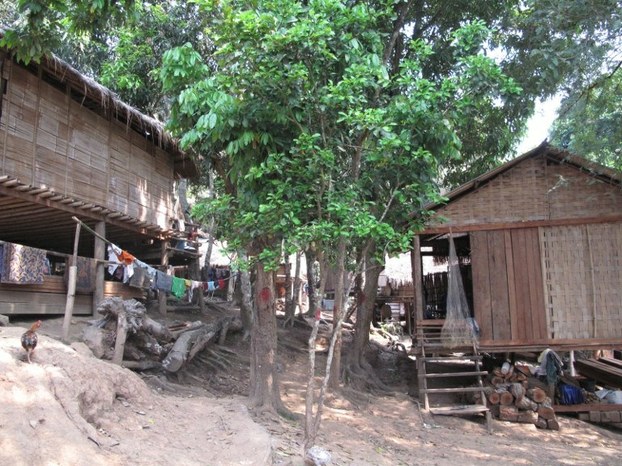Laos: Dark days for villagers relocated to make way for Xayaburi dam
| Publisher | Radio Free Asia |
| Publication Date | 1 July 2013 |
| Cite as | Radio Free Asia, Laos: Dark days for villagers relocated to make way for Xayaburi dam, 1 July 2013, available at: https://www.refworld.org/docid/51e699b28.html [accessed 31 May 2023] |
| Disclaimer | This is not a UNHCR publication. UNHCR is not responsible for, nor does it necessarily endorse, its content. Any views expressed are solely those of the author or publisher and do not necessarily reflect those of UNHCR, the United Nations or its Member States. |
2013-07-01
 Houses near the Xayaburi dam construction site in a photo taken on April 12, 2011. Bangkok Post/Piyaporn Wongruang
Houses near the Xayaburi dam construction site in a photo taken on April 12, 2011. Bangkok Post/Piyaporn Wongruang
UPDATED at 10:00 p.m. EST on 2013-06-30
Hundreds of Lao residents relocated to make way for the construction of a controversial dam on the Mekong River are in the dark after a landslide knocked down electrical wires in their village, according to a local official.
The 450 residents of Houay Hip village in Luangprabang's Nan district had been moved to the site from Pak Nern village beginning in July 2012 to make way for construction on the U.S. $3.5 billion Xayaburi dam, which resumed last year following delays amid objections from Laos's neighbors.
A coordinator for the Houay Hip relocation project told RFA's Lao Service that the landslide, caused by non-stop rains, had knocked down utility poles on Friday, severing electricity to the area, though no casualties were reported.
"The rain lasted two days, causing a landslide which damaged a few houses and knocked down four or five utility poles," he said, speaking on condition of anonymity.
"In the meantime, there's no electricity. Greater protection [for the village] is needed during the rainy season."
The coordinator expressed concerns on behalf of the Houay Hip villagers, who last month had told RFA that reinforcement of a nearby mountain was needed to protect against landslides in the event of heavy rain.
He said that the majority of the relocated villagers are unemployed and have no land to farm, making it difficult to earn a living.
The villagers were promised access to 25 kilowatts of free electricity as part of their relocation from Pak Nern and the coordinator said that they were worried the government would not repair the utility poles.
The relocation project is yet to be finalized one year after families began the move from their home site.
In addition to the 450 people from Pak Nern village who were relocated to Houay Hip, another 400 people have been moved from Houay Souy village in Xayaburi province to Nar Tor Yai village.
Some 1,100 more villagers are slated to be relocated as construction on the dam continues.
Earlier this month, officials said that some 2,000 villagers being relocated for the project will receive financial assistance for one year amid concerns about how the uprooted villagers will sustain their livelihoods in their new homes.
Lao government officials have previously said the villagers, who have relied on fish from the river and riverside gardens, will take an estimated five years to adjust to new livelihoods.
Environmentalists say the dam will directly affect the livelihoods of 200,000 people who rely on the river while threatening food security for millions more in the region.
Dam update
Meanwhile, an official from the Xayaburi project has said construction is now 10 percent complete – up from 8 percent in March – despite ongoing objections from environmental and rights groups, which have called for work on the dam to be suspended pending further impact studies.
"The project is about 10 percent completed," the official told RFA on condition of anonymity.
"Development of the two new [relocation] villages is done. The people relocated there will be cared for."
According to data the company provided for June, construction on service roads, bridges, and housing facilities for technicians and workers involved in the dam project is complete.
The Xayaburi dam will be the first to be built across the main stem of Southeast Asia's 4,000-kilometer (2,500-mile) waterway.
Once completed in 2018, the dam will generate electricity mostly for export to Thailand, forming a key part of landlocked Laos's plans to become the "battery of Southeast Asia" by selling electricity to its neighbors.
Reported by RFA's Lao Service. Translated by Viengsay Luangkhot. Written in English by Joshua Lipes.
Link to original story on RFA website
